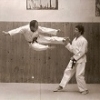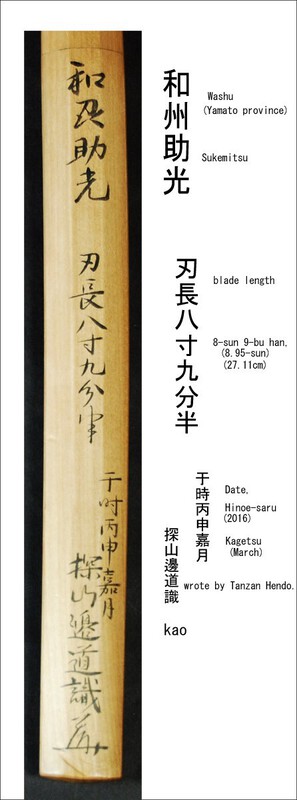-
Posts
8,632 -
Joined
-
Last visited
-
Days Won
51
Everything posted by Jean
-
As long as they are listed under Shinto, there is no problem. For obvious reason, Yamato Shinto and Koto cannot be mixed.
-
Sorry, but you are totally wrong Jimmy. Read what was writing Darcy Brockbank about Yamato swords: Quote: « I do have everything digital now and have been working on a project with about 5,000 hours in now. Markus has access to my project as he's been doing some contributions. So when stuff is fact it's very easy for both of us to confirm this. Studying the Juyo blades is just studying the best published discoveries of the last 60 years. Looking at them all is like having the eagle's perspective when everyone else is thrashing around in the mud. Ultimately being able to check them is what verifies a blade like your tanto is so rare and precious. Any signed Yamato work of Nanbokucho and earlier has to be held as particularly important as there are 318 that I've counted. This is including quasi-Yamato stuff like Mihara and Mino Senjuin etc. Also including things like Muromachi Yamato which is more commonly signed and not as important. I think with the five core schools the number is around 130 or 140. So when you have one you have something rare just on that basis. Anyone can find a nice blade. There are a lot of nice blades out there. Anyone can get a nice mumei Taema or mumei Yamato Shizu. There are many. But some blades are the items that we need in order to piece together the bigger picture. That's where things like this come in and those are the ones I try to get for my website when possible. Looking at the bigger picture and studying all the Juyo and Tokuju side by side further hammers home the point that there are Juyo blades and then there are a small sliver of these that stand apart for some reason. Because the average Western collector (and even Japanese collector) doesn't have this perspective they easily get lost in relativism, thinking that any two blades are equivalent because they have the same paper or so on. When you look at the numbers, there are more mumei Nagamitsu than there are signed Yamato blades from the 5 schools, Nanbokucho and earlier. Though Nagamitsu is held in high regard there is no way of knowing who made a Nagamitsu (they are all talented students but the point is that Nagamitsu is basically a brand name and the average westerner cannot tell the difference between the master's work and one of the students). we have the same problem with Rai Kunitoshi in that the NBTHK doesn't differentiate the various daimei works. If someone studies and takes the time as I've done then the six signatures stand out clearly. So we need to draw some conclusions from that. True master's work should be elevated a bit among the daimei. But it's up to you to know what you're looking at and why one Rai Kunitoshi may be more expensive than the other (or why it may be a good deal). Again with the two Kunitoshi you have about double the number of works in total as there are signed Yamato blades of Nanbokucho and earlier. I'm no huge fan of Yamato work on my own but there are standout blades and I think when one is signed it doesn't need anyone to stand up and have to write a lot about why it's special, it just is special on its own.»
-
I also checked in the « Japanese sword smiths » book (by Markus Sesko) and agree with Jussi. concerning sue Bizen mei, here is an opinion written by Darcy: Quote: Gimei or not?: post #27 Darcy The first smith that seems to have done this is Kunimune but it was not a habit. He has some examples that read "Kunimune Bizen Kuni Ju Osafune". All of the Juyo blades though are Nijimei with the exception of the Nakahara Kunimune blades. Sukemitsu in Bun'an (1444) is not recorded by Fujishiro as signing "Bizen Kuni Ju Osafune" but only using the Bishu style signature. The first smiths doing this by habit seems to have been Munemitsu (Bunmei, 1469) and Katsumitsu (Bunmei) and then Hikobeinojo Sukesada (Entoku). So it appears to have been something which comes up between these generations (Sukemitsu to Munemitsu/Katsumitsu). Fujishiro remarks on the habit as Osafune being used as a family name under the Kiyomitsu entry. He comments also under Munemitsu that "Osafune is the name of a place, but considered from the point that Osafune is inscribed after Bizen Kuni Ju, this means that Osafune is used like a surname. This example also appears in others of late Bizen" (i.e. Sue Bizen). The latest entry in the koto period which follows this pattern is for Yukikane and Harumitsu (Tensho). Harumitsu also signed unusually with Bishu Ju Osafune and Bushi Zen no Kuni Ju Osafune. He seems to have not always used the Osafune though. Hichibei Sukesada in the Shinto period (late 1600s) also used "Bizen Kuni Ju Osafune". The rest of his line seems to have continued to do this as there are entries in Kawachi no Kami Sukesada in 1688, and Godai Sukesada (Hichibei) 1751. Yokoyama Sukekane in the Shinshinto period is back to signing "Bizen Osafune Ju" (Keio, 1865) as does Sukenao (1854), Sukenaga (1830), and others I assume. My conclusion (which can also be picked up from several other books) is: 1. from Bunmei on, Osafune works in the Koto period, the rule of thumb is that Ju precedes Osafune. 2. if the order is not reversed, then the blade is most likely gimei 3. no general rule in swords is absolutely certain -- if only for the fact that we have certainly lost works so potential dissenting examples that break the rules have possibly been lost AND Japanese habit is to eliminate examples that break the rules. This further distorts the rule in that dissenting examples may seem to be more in the minority than they may have been at some point in the past, which means that conclusion #3 here needs to be respected (bearing in mind that it's a general rule itself!). 4. the reverse ordering clearly needs to be kept in mind in the Shinto period as well for Osafune smiths though it is not clear how tightly they kept to the habit without doing a full study of smiths more obscure than appear in Fujishiro. " Unquote
-
Just a tip, Steve, have a look at the yasurime (file marks on the nakago)
-
Welcome Henry John🙂
-
« everyone is entitled to an opinion, you're from France right? My my. » That’s the poorest answer I have ever read, My, my. This biaised opinion makes me think of opinions based on propaganda (Prieuré de Sion)
-
Jimmy, As a rule of thumb, nobody is entitled to state an opinion on a subject based on ear say. You don’t know the English Token, though I am French, I know it and furthermore his former chairman Paul B. Is a very good friend of mine and a fine gentleman. It is a very good association based on learning swords in hand or by lectures performed by very learned gentlemen. I am sure you can get a free invitation to a meeting. Subscribe, assist at meetings and then state your opinion, otherwise it is not worth a dime.
-
II think that Nambokucho is likely to have the largest Mihaba. ODENTA (Miike school) national treasure has a motohaba of 3,33 cm Motohaba of my former Osuriage Nambokucho Tametsugu is 3,2cm
-
Yes, it was from Ron😄
-

A Collector's Passing - Phil Wilsey
Jean replied to Peter Bleed's topic in General Nihonto Related Discussion
Very sad Peter. Condolences to family and friends. -

Translation assistance and identification
Jean replied to Dconekin's topic in Translation Assistance
With only these elements, I’ll say : No -

Why Kamakura = best swords ever??
Jean replied to Nicolas Maestre's topic in General Nihonto Related Discussion
BTW, this subject was already treated years ago on NMB and I remember Darcy had participated to the topic, it seems that the golden period spanned from roughly 1150 to 1350 -
Shortened traditionally made sword, signed Bishu Osafune…. (Province of Bizen, Osafune village…)
-
I have not locked a thread for ages so let me do it🤣😂
-
Dark hada, makes me think of northern provinces. Norishige/Tametsugu lineage is a possibility or Uda school.
-
Real Daisho are papered on the same kanteisho.
-
I remember that more than a decade ago, during one of our Kokusai Token Kai meeting, Zénon van Damme brought an engraved and signed wakizashi. It was made by Naotane in Yamashiro style and had these burls in the hada. He told us that they were a kantei point to Naotane.
-

Are organizations obsolete
Jean replied to Peter Bleed's topic in General Nihonto Related Discussion
When one relies upon others’ judgements to declare himself elitist, problems arise…. As it has been said blades must been judged according their own merits, independently of the smiths. It is what experts do for o suriage or mumei blades in Shinsa. Quality then determine the level of the kanteisho. A blade by a Rai smith, be his level saijo saku, may never reach Juyo level. The sword makes the smith and not the opposite. -

Are organizations obsolete
Jean replied to Peter Bleed's topic in General Nihonto Related Discussion
O kissaki are also found on Keicho swords. The O kissaki originated in the Nambokucho period and were in vogue between 1356 and 1368. -

Are organizations obsolete
Jean replied to Peter Bleed's topic in General Nihonto Related Discussion
Question has been asked, Jacques, and I am sure you’ll answer it. -

Recent listing on Ebay,...thoughts?
Jean replied to Z-Man's topic in General Nihonto Related Discussion
I don’t know if Darcy’s articles are still available but there was one related to the rating/ranking system. a very good shop, one of the top, if not the best one is Sokendo. You will find swords from 5K¥ upto no limit (several 10M¥). -
-
Very strange shinogi……..







